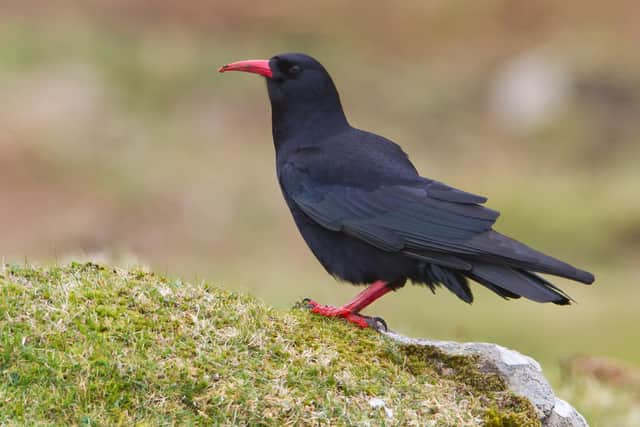Action to save acrobatic Chough bird from extinction in Scotland 'must be stepped up'
Specialists believe the red-billed chough is merely “clinging on” to existence in its last Scottish stronghold on the western islands of Islay and Colonsay.
It is estimated there are as few as 50 pairs left on the islands – currently the lowest count anywhere in the British Isles.
Advertisement
Hide AdAdvertisement
Hide AdA report commissioned by NatureScot, reviewing chough management across the UK and Ireland, argues that sustainable, long-term support is needed immediately to stop Scotland’s population becoming extinct in the next few decades.
Changes in how land is used, the impact of parasites and food shortages have been blamed for the drop in numbers of the species, which has been declining across Europe.
NatureScot ornithologist Dave Parish said: “Chough rely heavily on agricultural and coastal grasslands, and mainly feed on the invertebrates found in soil and the dung of livestock – cattle in particular – preferring to forage in short, grazed grassland.
“However, modern agricultural practices support less of the insects that chough need, which has impacted juvenile survival in Scotland.


“Coupled with a limited supply of nest sites, decreasing genetic diversity in the population and an increase in harmful parasites, these corvids are facing a bleak future, with studies predicting they may be lost from Scotland within 50 years without our help.”
A dedicated group of people have been studying chough and laying out extra food around the islands in recent years to try and boost survival rates of young birds.
However, Scotland’s nature agency believes further action is needed, including improvements to habitats to provide more insects for chough to eat to ensure Scotland’s population has a future.
Mr Parish said: “Support for farmers to carry out chough-friendly practices and provide robust nest sites for the birds is key to maintaining chough populations in Scotland.
Advertisement
Hide AdAdvertisement
Hide Ad“The new report pulls together information from successful conservation projects across the UK and Ireland.
“Coupled with our experience gained from working with the many passionate farmers on Islay and Colonsay, we can devise revised, and hopefully better, measures for the new agriculture support package that is being developed.”
Experts are also considering releasing birds bred from different stock into the Scottish population as a means to ultimately strengthen their ability to resist parasite infections.
Mr Parish added: “This important species is facing a tough time in Scotland, but our work with partners in the Scottish Chough Forum and elsewhere has shown us exactly what the problems are and how we might resolve them.
“We hope partners will continue to work together to help save Scotland’s chough.”
Gavin Siriwardena, head of the terrestrial ecology team at the British Trust of Ornithology, which undertook the review of chough management, believes there are a number of improvements that could be made.
“Chough populations across Britain and Ireland are highly fragmented, and conservation work is currently not strongly co-ordinated,” he said.
“All interested groups, and the species itself, would benefit from more consistent reporting of demographic and count data.
Advertisement
Hide AdAdvertisement
Hide Ad“Formal studies of the effectiveness of the management measures implemented under schemes like the Agri-Environment Climate Scheme in Scotland would also be very valuable.”
Choughs are members of the crow family, identifiable by their black feathers and bright scarlet bill and legs.
Around a century ago chough could be found on the east coast of Scotland, and bones of the species have been found in Orkney.
Today their range is severely retracted, with the remaining Scottish populations confined to Colonsay, Islay and Jura.
Elsewhere they are found only in the far west of Cornwall, western and northern Wales, the Isle of Man and the southern, western and northern coasts of the island of Ireland.
The birds live in western rocky landscapes, from seacliffs to mountains, breeding in coastal caves above the high-water mark, quarry tunnels and sometimes crevices in abandoned stone constructions.
Adults can remain faithfully paired for multiple years.
The species is a master flier and can be seen showing off its acrobatic skills with dramatic aerial displays of diving and swooping.
Comments
Want to join the conversation? Please or to comment on this article.